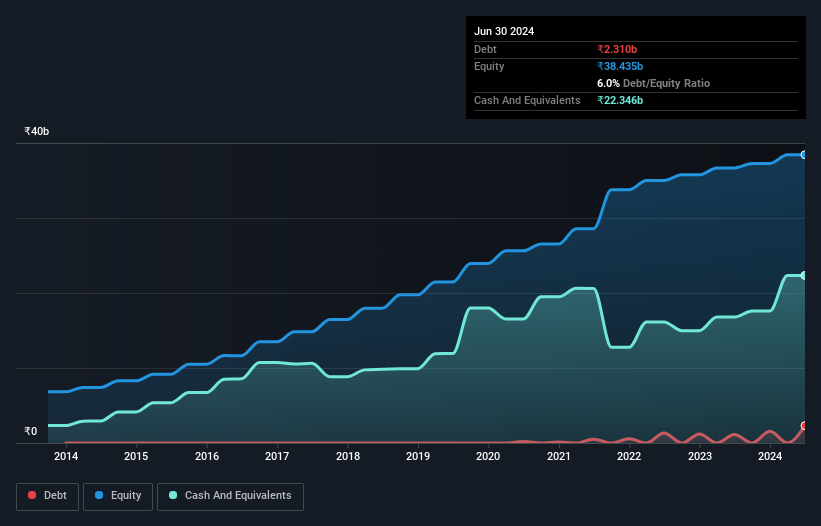- India
- /
- Consumer Durables
- /
- NSEI:WHIRLPOOL
Whirlpool of India (NSE:WHIRLPOOL) Could Easily Take On More Debt
David Iben put it well when he said, 'Volatility is not a risk we care about. What we care about is avoiding the permanent loss of capital.' It's only natural to consider a company's balance sheet when you examine how risky it is, since debt is often involved when a business collapses. We can see that Whirlpool of India Limited (NSE:WHIRLPOOL) does use debt in its business. But the more important question is: how much risk is that debt creating?
When Is Debt A Problem?
Debt assists a business until the business has trouble paying it off, either with new capital or with free cash flow. Part and parcel of capitalism is the process of 'creative destruction' where failed businesses are mercilessly liquidated by their bankers. While that is not too common, we often do see indebted companies permanently diluting shareholders because lenders force them to raise capital at a distressed price. Of course, plenty of companies use debt to fund growth, without any negative consequences. When we think about a company's use of debt, we first look at cash and debt together.
View our latest analysis for Whirlpool of India
What Is Whirlpool of India's Net Debt?
The image below, which you can click on for greater detail, shows that at March 2024 Whirlpool of India had debt of ₹2.31b, up from ₹1.12b in one year. However, its balance sheet shows it holds ₹22.3b in cash, so it actually has ₹20.0b net cash.

A Look At Whirlpool of India's Liabilities
Zooming in on the latest balance sheet data, we can see that Whirlpool of India had liabilities of ₹17.7b due within 12 months and liabilities of ₹5.28b due beyond that. On the other hand, it had cash of ₹22.3b and ₹4.38b worth of receivables due within a year. So it can boast ₹3.77b more liquid assets than total liabilities.
Having regard to Whirlpool of India's size, it seems that its liquid assets are well balanced with its total liabilities. So while it's hard to imagine that the ₹266.4b company is struggling for cash, we still think it's worth monitoring its balance sheet. Simply put, the fact that Whirlpool of India has more cash than debt is arguably a good indication that it can manage its debt safely.
In addition to that, we're happy to report that Whirlpool of India has boosted its EBIT by 48%, thus reducing the spectre of future debt repayments. When analysing debt levels, the balance sheet is the obvious place to start. But it is future earnings, more than anything, that will determine Whirlpool of India's ability to maintain a healthy balance sheet going forward. So if you're focused on the future you can check out this free report showing analyst profit forecasts.
Finally, a business needs free cash flow to pay off debt; accounting profits just don't cut it. While Whirlpool of India has net cash on its balance sheet, it's still worth taking a look at its ability to convert earnings before interest and tax (EBIT) to free cash flow, to help us understand how quickly it is building (or eroding) that cash balance. Happily for any shareholders, Whirlpool of India actually produced more free cash flow than EBIT over the last three years. That sort of strong cash generation warms our hearts like a puppy in a bumblebee suit.
Summing Up
While we empathize with investors who find debt concerning, you should keep in mind that Whirlpool of India has net cash of ₹20.0b, as well as more liquid assets than liabilities. The cherry on top was that in converted 100% of that EBIT to free cash flow, bringing in ₹5.4b. So we don't think Whirlpool of India's use of debt is risky. When analysing debt levels, the balance sheet is the obvious place to start. But ultimately, every company can contain risks that exist outside of the balance sheet. For example, we've discovered 1 warning sign for Whirlpool of India that you should be aware of before investing here.
At the end of the day, it's often better to focus on companies that are free from net debt. You can access our special list of such companies (all with a track record of profit growth). It's free.
Valuation is complex, but we're here to simplify it.
Discover if Whirlpool of India might be undervalued or overvalued with our detailed analysis, featuring fair value estimates, potential risks, dividends, insider trades, and its financial condition.
Access Free AnalysisHave feedback on this article? Concerned about the content? Get in touch with us directly. Alternatively, email editorial-team (at) simplywallst.com.
This article by Simply Wall St is general in nature. We provide commentary based on historical data and analyst forecasts only using an unbiased methodology and our articles are not intended to be financial advice. It does not constitute a recommendation to buy or sell any stock, and does not take account of your objectives, or your financial situation. We aim to bring you long-term focused analysis driven by fundamental data. Note that our analysis may not factor in the latest price-sensitive company announcements or qualitative material. Simply Wall St has no position in any stocks mentioned.
About NSEI:WHIRLPOOL
Whirlpool of India
Manufactures and markets home appliances in India and internationally.
Flawless balance sheet and good value.
Similar Companies
Market Insights
Community Narratives



